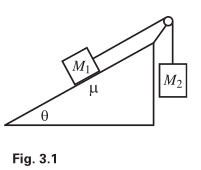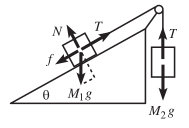Post History
Mass M1 is held on a plane with inclination angle θ, and mass M2 hangs over the side. The two masses are connected by a massless string which runs over a massless pulley (see Fig. 3.1). The c...
#1: Initial revision
Why used $\cos\theta$ for $\text{y}$ axis or, gravitational force?
><br/>
>Mass M1 is held on a plane with inclination
angle θ, and mass M2 hangs over the side. The two masses are connected by a
massless string which runs over a massless pulley (see Fig. 3.1). The coefficient of
kinetic friction between M1 and the plane is µ. M1 is released from rest. Assuming that
M2 is sufficiently large so that M1 gets pulled up the plane, what is the acceleration
of the masses? What is the tension in the string?
Then, they were writing force of that figure.
$$T-f-M_1g\sin \theta = M_1a$$
$$N-M_1g\cos \theta=0$$
$$M_2g-T=M_2a$$
In the second equation they wrote that $$M_1g\cos \theta$$
Usually, $\cos$ is used when we think of $\text{x}$ axis. Since, $$\cos \theta=\frac{\color{blue}\text{base}}{\text{hypotenuse}}$$
But, gravitational force is forever through $\text{y}$ axis. Although, why they used $\cos\theta$ for gravitational force.


















